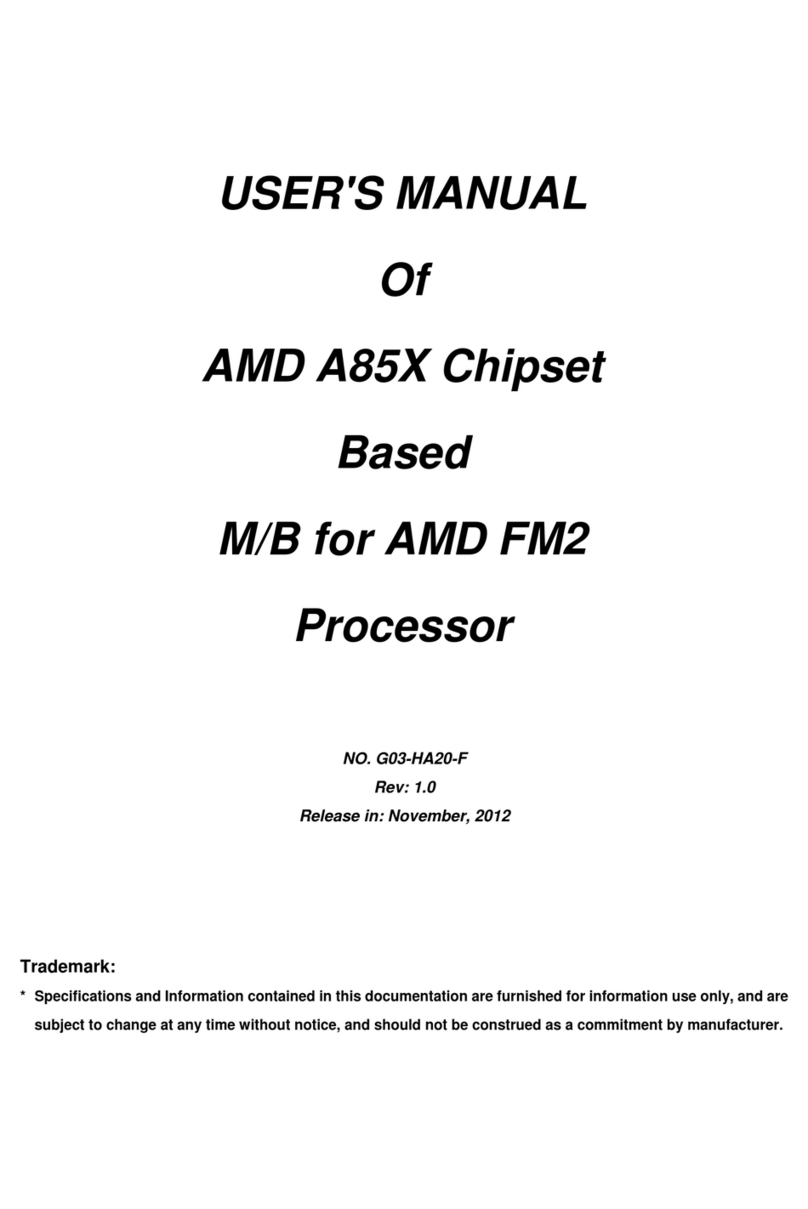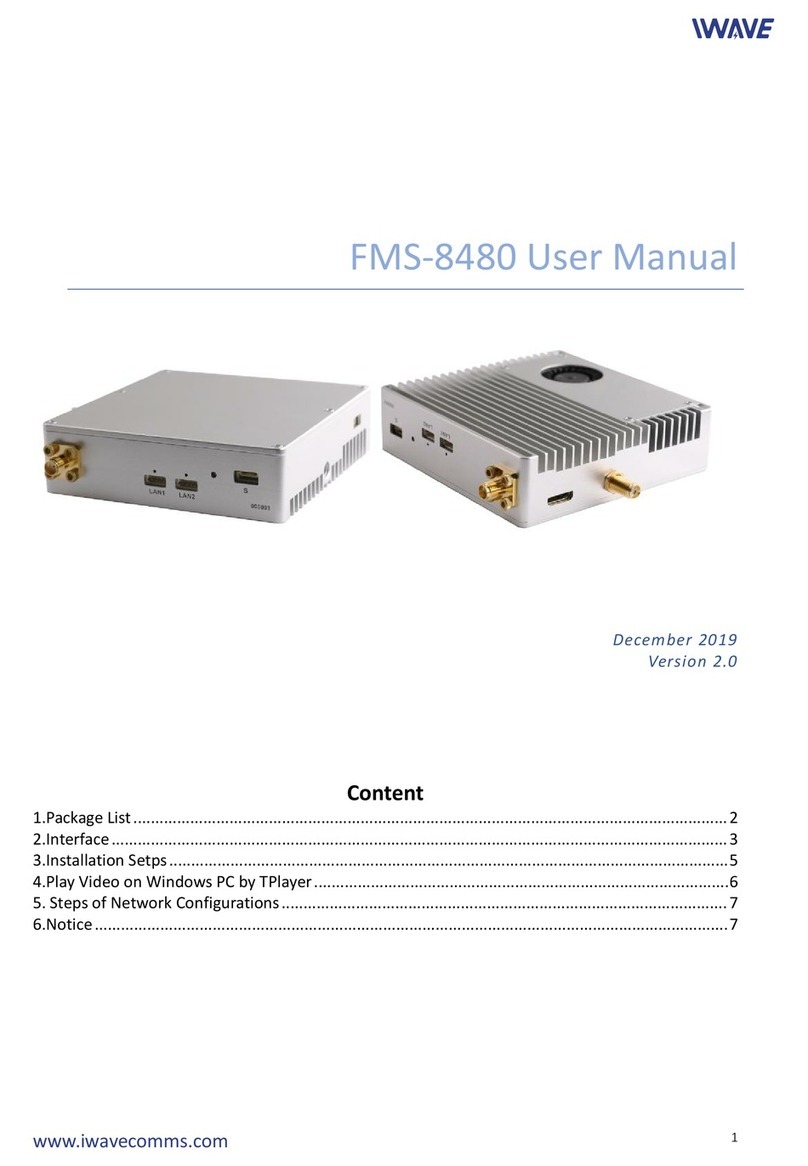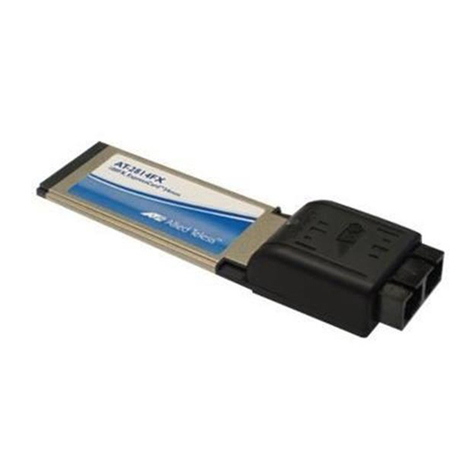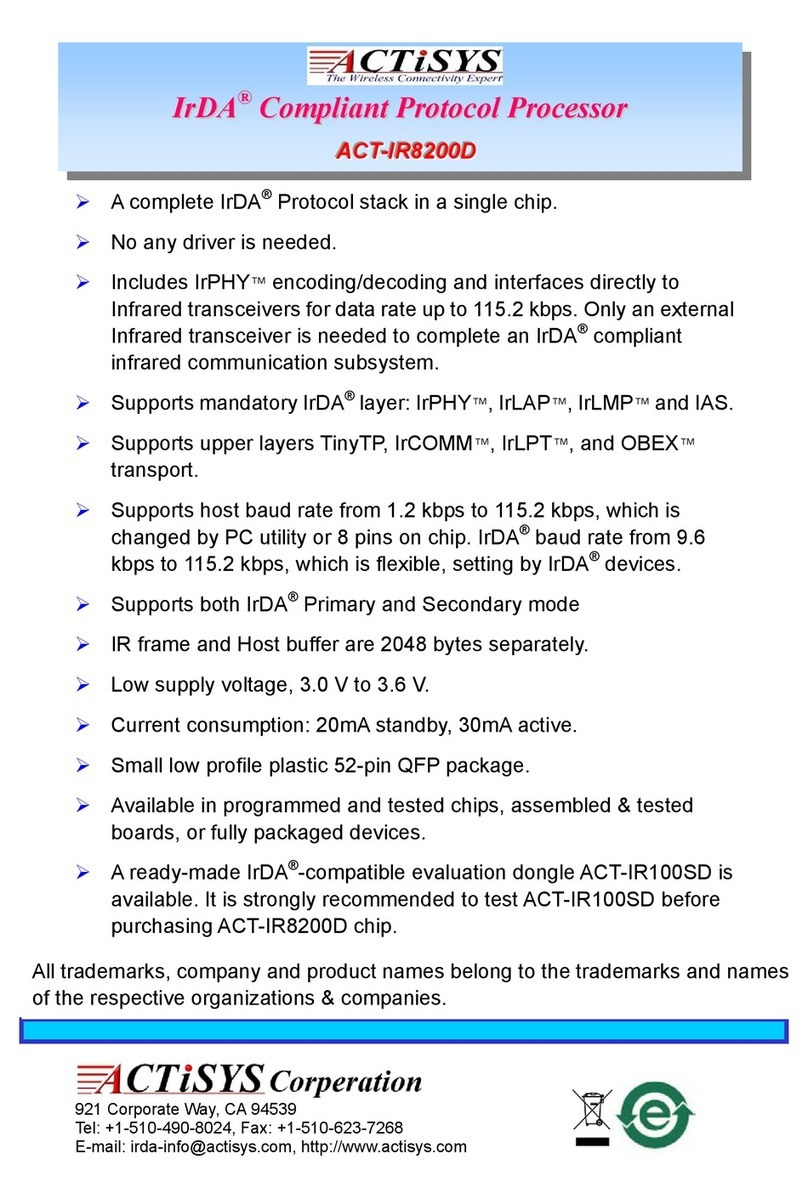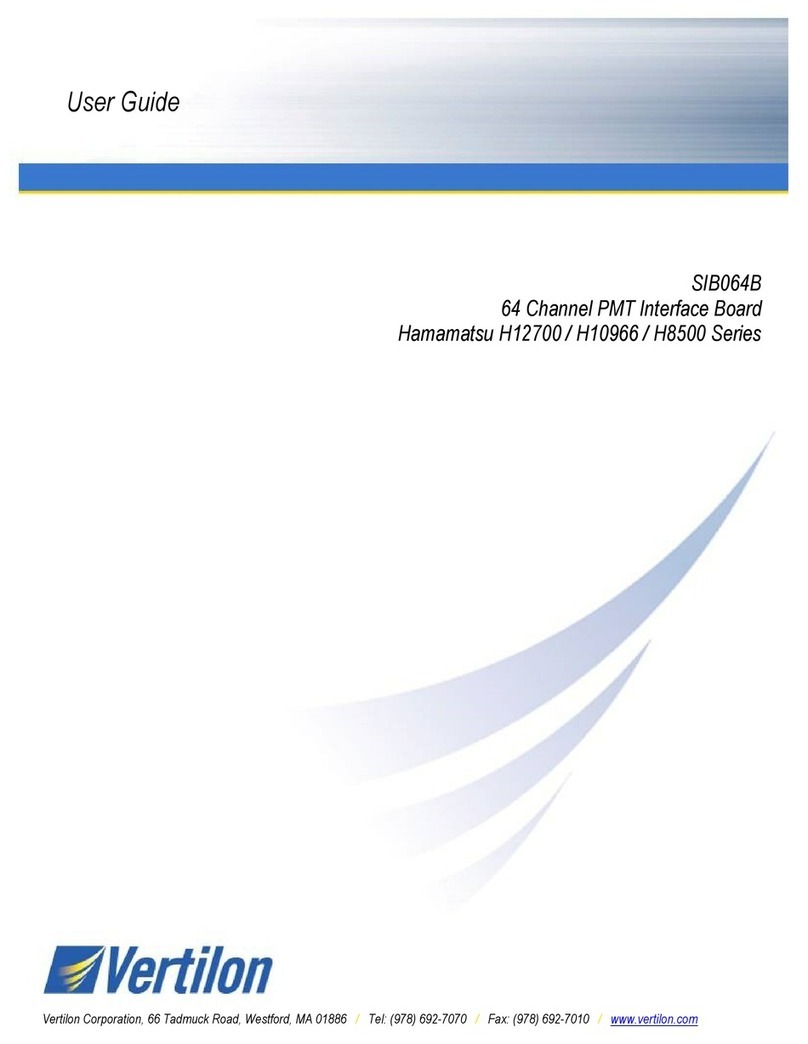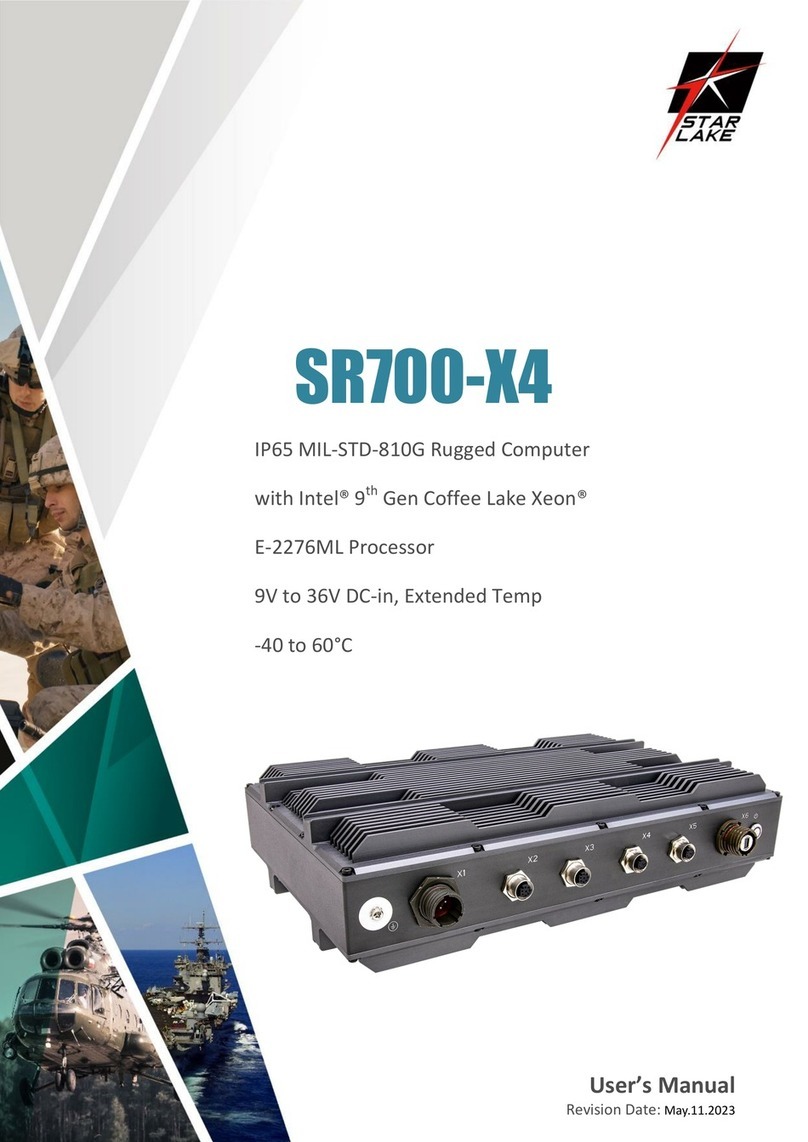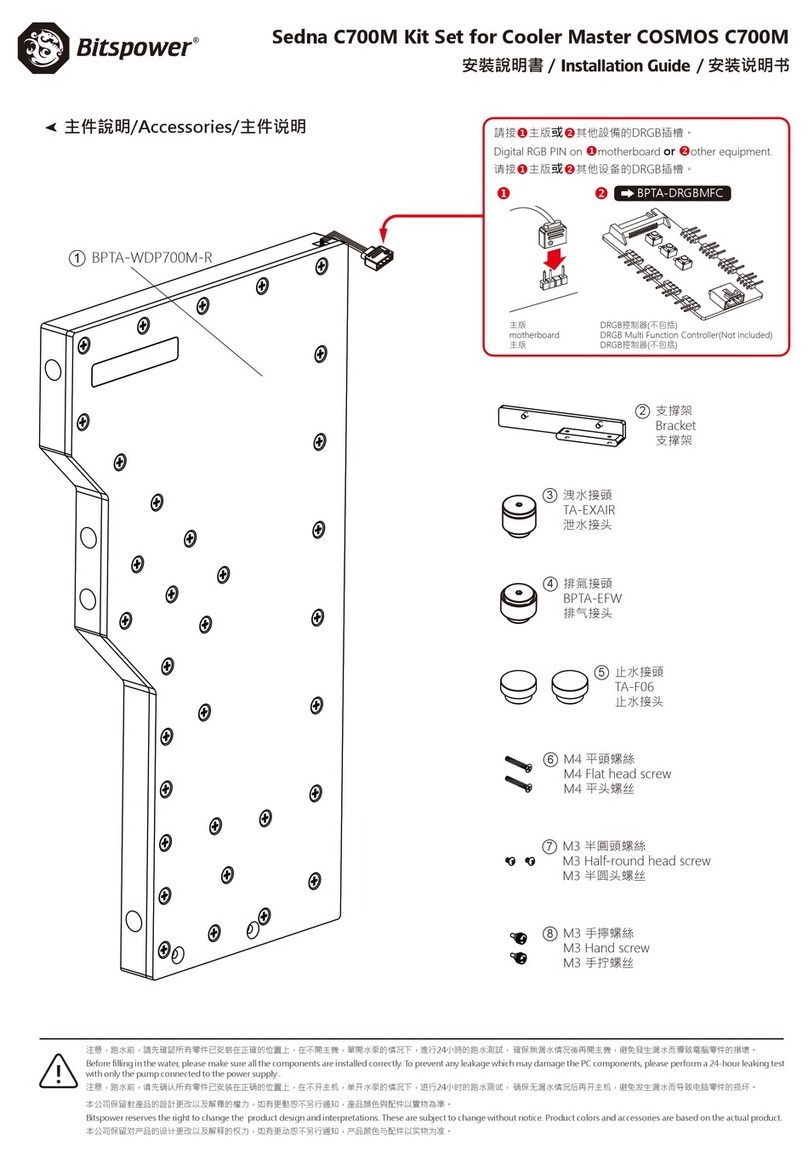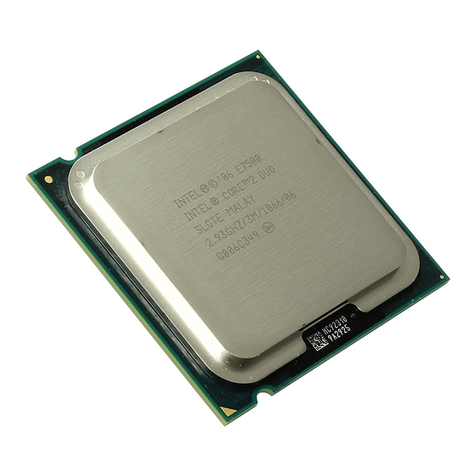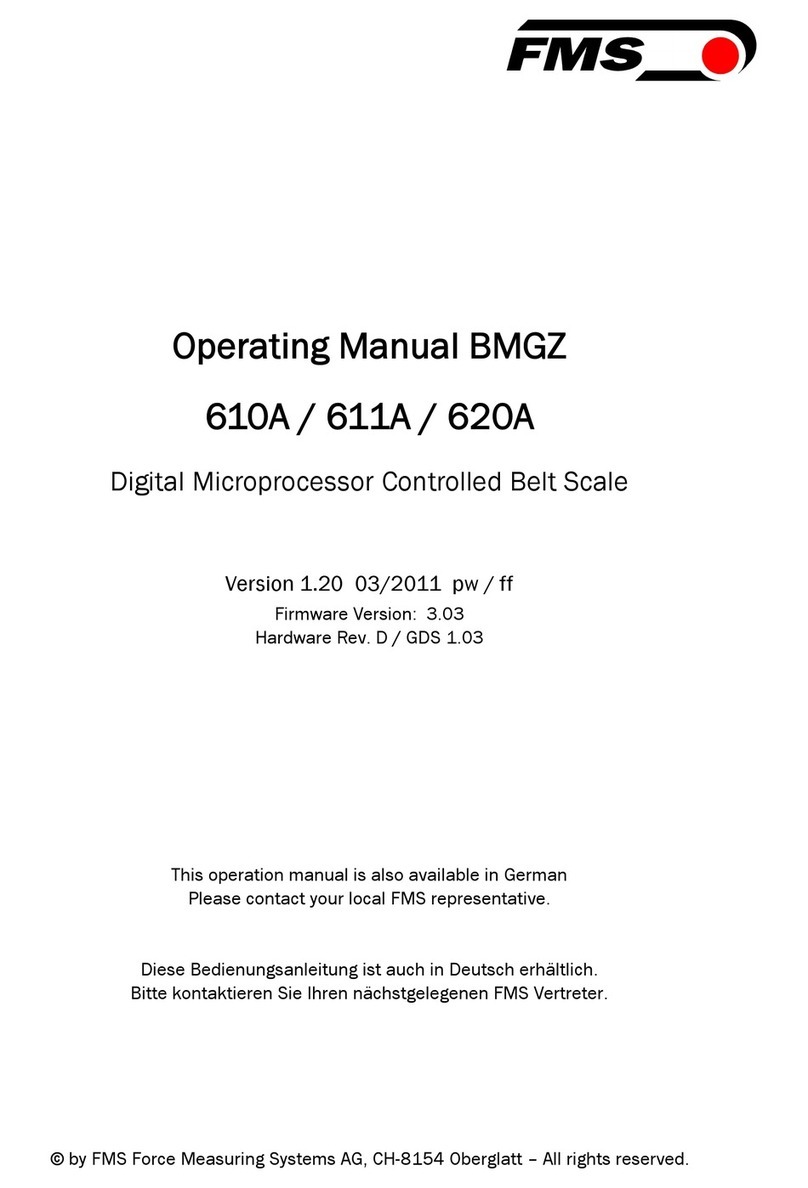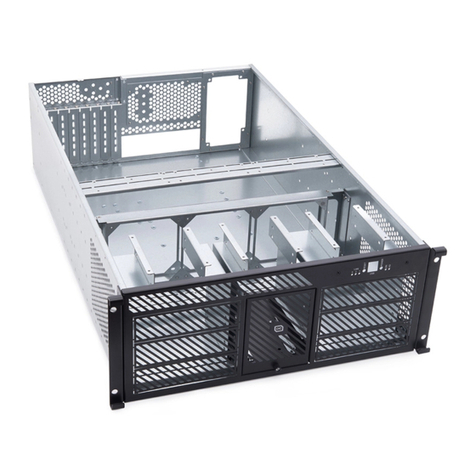EVOC PCL-726 User manual

PCL-726
6-Channel D/A
Output Card

@Copyright 1997-2000 EVOC Technology Co., Ltd.
All Rights Reserved.
The information in this document is subject to change without prior notice in order
to improve reliability, design and function and does not represent a commitment on
the part of the manufacturer.
In no event will the manufacturer be liable for direct, indirect, special, incidental, or
consequential damages arising out of the use or inability to use the product or
documentation, even if advised of the possibility of such damages.
This document contains proprietary information protected by copyright. All rights
are reserved. No part of this manual may be reproduced by any mechanical,
electronic, or other means in any form without prior written permission of the
manufacturer.
Trademarks
PCL-726 is registered trademarks of EVOC Technology Co., Ltd. IBM PC is a
registered trademark of International Business Machines Corporation. Intel is a
registered trademark of Intel Corporation. Other product names mentioned herein
are used for identification purposes only and may be trademarks and/or registered
trademarks of their respective companies.

Contents
•
i
CONTENT
HOW TO USE THIS GUIDE
...................................................................... II
INTRODUCTION
............................................................................................. 1
1.1 FEATURES....................................................................................................... 1
1.2 APPLICATIONS :............................................................................................... 2
1.3 SPECIFICATIONS:............................................................................................. 2
INSTALLATION
.............................................................................................. 5
2.1 WHAT YOU HAVE............................................................................................ 5
2.2 UNPACKING..................................................................................................... 6
2.3 PCL-726'S LAYOUT......................................................................................... 7
2.4 JUMPER AND DIP SWITCH DESCRIPTION........................................................... 8
2.5 BASE ADDRESS SETTING.................................................................................. 8
2.6 IRQ LEVEL SETTING ..................................................................................... 10
2.7 D/A OUTPUT CONFIGURATION....................................................................... 10
2.8 CONNECTOR PIN ASSIGNMENT....................................................................... 13
2.9 SIGNAL CONNECTION .................................................................................... 15
2.9.1 Voltage Output Connection.................................................................... 15
2.10 SOFTWARE INSTALLATION .......................................................................... 16
PROGRAMMING
........................................................................................... 18
3.1 I/O PORT ADDRESS ....................................................................................... 18
3.2 D/A DATA REGISTER..................................................................................... 19
3.2.1 Unipolar Numbering.............................................................................. 20
3.2.2 Bipolar Numbering................................................................................ 20
3.3 DIGITAL I/O REGISTER .................................................................................. 21
3.4 DEMONSTRATION PROGRAMS......................................................................... 22
PCL-726 CALIBRATION
........................................................................... 23
4.1 ENVIRONMENT AND TOOLS ............................................................................ 23
4.2THE DISTRIBUTION OF VARIABLE PRECISE RESISTOR.......................................... 23
4.3 CALIBRATION STEPS ...................................................................................... 23
APPENDIX A. I/O PORT ADDRESS MAP........................................................ 26


ii
•
Contents
How to Use This Guide
This manual is written to help you use the PCL-726. The manual describes how to
modify various settings on the PCL-726 card to meet your requirements. It is divided
into four chapters.
lChapter 1, “Introduction,”gives an overview of the product features.
applications and specifications.
lChapter 2, “Installation,”describes how to install the PCL-726. The layout of
PCL-726 is shown, the jumper setting for base address, interrupt IRQ level and
D/A output ranges are specitied as well. Besides, all connectors’pin assignment
are also specified.
lChapter 3, “Programming ,”describes how to program the PCL-726 for analog
outputs and digital I/O.
lChapter 4, “PCL-726 Calibration, ”describes the calibration of PCL-726 for
different voltage and current output.
lAppendix A, “I/O Port Address Map,”gives an overview I/O address map.


Introduction
•
1
1
Introduction
The PCL-726 provides 6-channel analog outputs, 16-channel digital
inputs and 16-channel digital outputs add-on card for the IBM
Personal Computer and compatible computers. It is designed for
industrial control applications requiring analog outputs ( voltage and
current )with 12-bit resolution in rugged environment.
The PCL-726 transmits six analog outputs with individually user
configurable ranges of :
0 ~ +10V, 0 ~ +5V, ±10V, ±5V, and 4 to 20 mA current loop.
Each D/A has a double-buffered output for single-step update and
occupies its own I/O location. Also, A rugged and reliable 37-pin D-
sub style connector is provided for analog outputs.
In addition to the 6 analog outputs, the PCL-726 has 16 digital inputs
and 16 digital outputs, all of the digital channels are TTL compatible.
The PCLD-782 ( 16-bit Isolation digital input board)and PCLD-785
( 16-bit relay output board) are designed for going with the digital
input and output connection.
The PCL-726 uses the state-of-the-art technology and components to
design this card. Its compact size PCB board let this card easily fit
into any kind of chassis. Also, all the components on the card are
SMT type; it improves the reliability and quality of this card.
1.1 Features
The PCL-726 6-channel D/A Output Card provides the following
advanced features:
•Supports AT/Bus

2
•
Introduction
•Six multiplying analog output channels
•12-bit resolution, double buffered D/A converter
•Multiple Voltage Range : Unipolar : 0 ~ +5 V , 0 ~ +10 V
Bipolar : ±5 V, ±10 V
Current Loop : 4 ~ 20mA
•All D/A outputs will be 0V after RESET or POWER-ON
•16 digital output channels
•16 digital input channels
•Enhanced IRQ capability from IRQ3 to IRQ15
•Register structure is fully compatible with Advantech's PCL-726
1.2 Applications :
•Industrial and laboratory ON/OFF control
•Energy management
•Function Generator
•Programmable Voltage Source
•Security controller
•DIP Loop Control
•Programmable Current Sink
•Waveform and pulse generation
1.3 Specifications:
♦
Analog Output( D/A )
•
Channel : 6 channels
•
Resolution :12-bit, double buffered output
•
Output ranges : Unipolar :0V~+5V or 0~+10V
Bipolar : ±5V

Introduction
•
3
4 ~ 20mA current loop( sink)
•
Reference Voltage : ±10V with external DC or AC
reference; Internal : -5V or -10V
•
Current Loop : External : +10V or -10V max.
•
Current Loop exciting
voltage : 4 ~ 20 mA (sink) 8V(min.) ,
36V(max.) for current loop
4mA ~ 20mA
•
Conversion type : monolithic multiplying
•
Converter : B.B. DAC7541 AJP or equivalent
•
Settling time : 70 microsecond
•
Linearity : ±1/2 bit
•
Accuracy : ±0.012% full scale range
•
Voltage output drive : ±5mA max.
•
Output initial status : 0V ( after RESET or POWER-ON)
♦
Digital Input( D/I )
•
Channel : 16 channels
•
Level : TTL compatible
•
Input logic low voltage : Min. -0.5V; Max. 0.8V
•
Input logic high voltage : Min. 2.0V; Max. 5.0V
•
Input loading current :Max. 0.2 mA at 0.4V
•
Input hysteresis : Typical 0.4V; Min. 0.2V
♦
Digital Output( D/O )
•
Channel : 16 channels
•
Level : TTL compatible
•
Input logic low voltage : Max. 0.5V at 24mA
(Sink) Max. 0.4V at 12mA
•
Input logic high voltage : Min 2.0V at 15mA;
(Source) Min. 2.4V at 3mA
•
Driving Capacity :All inputs and outputs are TTL/DTL
compatible and outputs will drive
standard TTL load ( 74 series) or
LSTTL ( 74LS) loads
•
Input hysteresis : Typical 0.4V; Min. 0.2V

4
•
Introduction
♦
General Specification
•
Dimensions : Half-Size ( 162 mm X 116 mm)
•
Bus :PC/AT bus
•
Slot : One 36 pin slot and one 62-pin slot
•
I/O connectors : 37-pin D-sub connector ( analog output)
20-pin ribbon connector ( digital I/O)
•
Operating temp. :0°~ 50°C
•
Storage temp. : -20°~ 70°C
•
Humility :5% ~ 95%, non-condensing
•
Power Consumption : +5V : 360mA typical, 450 max.
+12V : 50mA typical, 110mA max.
-12V : 14mA typical, 90mA max.

Installation
•
5
2
Installation
This chapter describes how to install the PCL-726. At first, the
contents in the package and unpacking information that you should
be careful are described. The jumpers and switches setting for the
PCL-726's base address and voltage source are also specified.
2.1 What You Have
In addition to this User's Manual, the package includes the following
items:
•PCL-726 6-channel Analog Output Card
•Utility Diskette
If any of these items is missing or damaged, contact the dealer from
whom you purchased the product. Save the shipping materials and
carton in case you want to ship or store the product in the future.

6
•
Installation
2.2 Unpacking
Your PCL-726 card contains sensitive electronic components that can
be easily damaged by static electricity.
The card should be done on a grounded anti-static mat. The operator
should be wearing an anti-static wristband, grounded at the same
point as the anti-static mat.
Inspect the card module carton for obvious damage. Shipping and
handling may cause damage to your module. Be sure there are no
shipping and handing damages on the module before processing.
After opening the card module carton, extract the system module and
place it only on a grounded anti-static surface component side up.
Again inspect the module for damage. Press down on all the socketed
IC's to make sure that they are properly seated. Do this only with the
module place on a firm flat surface.
Note : DO NOT APPLY POWER TO THE CARD IF IT HAS BEEN
DAMAGED.
You are now ready to install your PCL-726.

Installation
•
7
2.3 PCL-726's Layout
Figure 2.1 PCL-726’s Layout

8
•
Installation
2.4 Jumper and DIP Switch Description
You can configure the output of each channel and base address by
setting jumpers and DIP switches on the PCL-726. The card's
jumpers and switches are preset at the factory. Under normal
circumstances, you should not need to change the jumper settings.
A jumper switch is closed (sometimes referred to as "shorted") with
the plastic cap inserted over two pins of the jumper. A jumper is open
with the plastic cap inserted over one or no pin(s) of the jumper.
2.5 Base Address Setting
The PCL-726 requires 16 consecutive address locations in I/O
address space. The base address of the PCL-726 is restricted by the
following conditions.
1. The base address must be within the range 200hex to 3F0hex.
2. The base address should not conflict with any PC reserved
I/O address. see Appendix A.
The PCL-726's I/O port base address is selectable by an 8 position
DIP switch SW1 ( refer to Table 2.1). The address settings for I/O
port from Hex 200 to Hex 3F0 is described in Table 2.2 below. The
default base address of your PCL-726 is set to hex 2C0 in the
factory( see Figure 2.1).

Installation
•
9
SW1 : Base Address = 0x2C0
123456
ON DIP
A ( 8 7 6 5 4 NC )
Figure 2.2 Default Base Address Setting
I/O port
address(hex) fixed
A9 1
A8 2
A7 3
A6 4
A5 5
A4
200-20F OFF
(1) ON
(0) ON
(0) ON
(0) ON
(0) ON
(0)
210-21F OFF
(1) ON
(0) ON
(0) ON
(0) ON
(0) OFF
(1)
:
(*) 2C0-2CF OFF
(1) ON
(0) OFF
(1) OFF
(1) ON
(0) ON
(0)
:
300-30F OFF
(1) OFF
(1) ON
(0) ON
(0) ON
(0) ON
(0)
:
3F0-3FF OFF
(1) OFF
(1) OFF
(1) OFF
(1) OFF
(1) OFF
(1)
(*) : default setting ON : 0
X : don't care OFF : 1
Note : A4, ..., A9 correspond to PC bus address lines.
Table 2.1

10
•
Installation
2.6 IRQ Level Setting
A hardware interrupt can be triggered by the external Interrupt signal which
is from pin 17 of CN3 connector. Its correspond interrupt IRQ levels can be
selected by jumper JP7.The jumper setting is specified as below:
Note : Be aware that there is no other add-on card shares the same interrupt
level at the same system.
Note : External trigger source is from Pin-17 of CN3
Figure 2.3 IRQ Setting
2.7 D/A Output Configuration
The PCL-726‘s output channels can be configured as different analog output
styles, and they are depended on D/A converter's reference voltage source
and output mode( Bipolar or Unipolar). The reference voltage can be
internal generated or by external reference voltage from the Reference
Voltage Input ( REF.IN) of connector CN3. Each output channel and its
corresponding jumper are listed as follow.
CHANNEL NO. Corresponding Jumper
CH0 JP1-3
CH1 JP2-3
CH2 JP3-3
CH3 JP4-3
CH4 JP5-3
CH5 JP6-3

Installation
•
11
The jumper settings for each output channel are illustrated as Figure 2.4
below. The internal -5V is set as default reference voltage.
Reference
Voltage
Source External Ref. -10V Ref. -5V Ref.
( default )
Jumper
Setting
EXT
-5V
-10V EXT
-5V
-10V EXT
-5V
-10V
Figure 2.4 Reference Voltage Source
Besides, each output channel can be set as Bipolar or Unipolar output. Each
output channel and its corresponding jumpers for mode setup are listed as
follow. CHANNEL NO. Corresponding Jumper
for output mode
CH0 JP1-1, JP1-2
CH1 JP2-1, JP2-2
CH2 JP3-1, JP3-2
CH3 JP4-1, JP4-2
CH4 JP5-1, JP5-2
CH5 JP6-1, JP6-2
The jumper settings for output channel CH0 are illustrated as Figure 2.5
below. The Unipolar mode is default setting.

12
•
Installation
The different output ranges of output CH0 are shown as the following table.
The settings for reminder channels(CH1 ~ CH5) should follow the same
rules as CH0.

Installation
•
13
2.8 Connector Pin Assignment
The PCL-726 comes equipped with one 37-pin D-sub (CN3) and two
20-pin insulation displacement connectors (CN1 and CN2). The P1 is
located at the rear plate; the CN1 and CN2 are located on board.
CN3 is used for analog outputs and reference voltage input, CN2 for
digital inputs, CN1 digital outputs. Each connector's pin assignment is
specified as follows:
Legend :V.OUT : Analog Voltage Output
I.OUT : Analog Current Output
A.GND : Analog Ground
D/A : Analog Output
D.GND : Digital Ground
REF.OUT: Reference Voltage Output
REF.IN : Reference Voltage Input
EXT TRG : External Interrupt Trigger
DO : Digital Output
DI : Digital Input
NC : No Connection

14
•
Installation
Table of contents
Other EVOC Computer Hardware manuals


